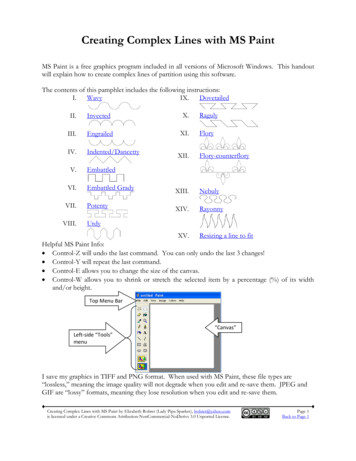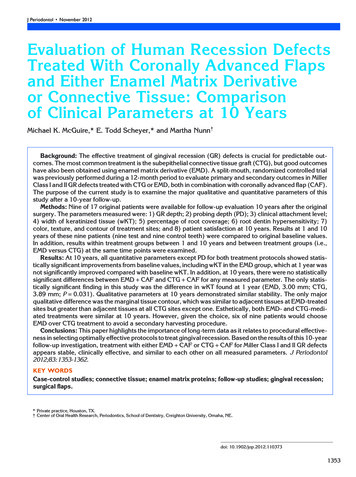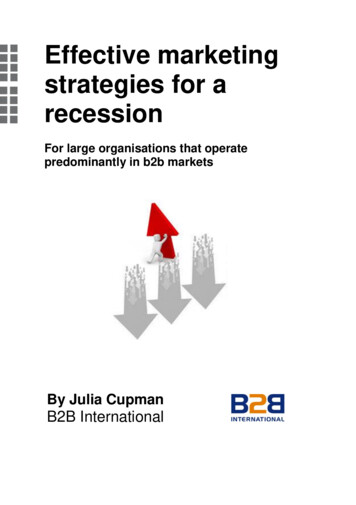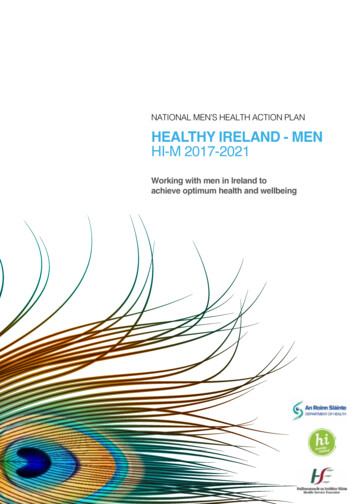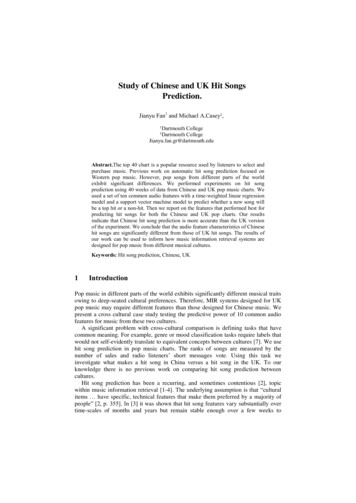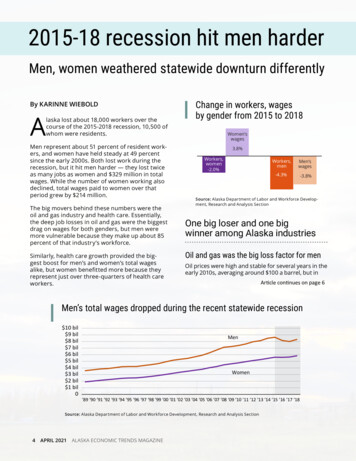
Transcription
2015-18 recession hit men harderMen, women weathered statewide downturn differentlyBy KARINNE WIEBOLDA5.0%laska lost about 18,000 workers over the4.0%course of the 2015-2018 recession, 10,5003.0% ofwhom were residents.Change in workers, wagesby gender from 2015 to 2018Women’swages2.0%Men represent about 51 percent of resident 1.0%work0.0%ers, and women have held steady at 49 percentsince the early 2000s. Both lost work during-1.0%therecession, but it hit men harder — they lost-2.0%twiceas many jobs as women and 329 million in total-3.0%wages. While the number of women workingalso-4.0%declined, total wages paid to women over thatperiod grew by 214 million.-5.0%The big movers behind these numbers were theoil and gas industry and health care. Essentially,the deep job losses in oil and gas were the biggestdrag on wages for both genders, but men weremore vulnerable because they make up about 85percent of that industry’s workforce.Similarly, health care growth provided the biggest boost for men’s and women’s total wagesalike, but women benefitted more because theyrepresent just over three-quarters of health �swages-4.3%-3.8%Source: Alaska Department of Labor and Workforce Development, Research and Analysis SectionOne big loser and one bigwinner among Alaska industriesOil and gas was the big loss factor for menOil prices were high and stable for several years in theearly 2010s, averaging around 100 a barrel, but inArticle continues on page 6Men’s total wages dropped during the recent statewide recession 10 bil 9 bil 8 bil 7 bil 6 bil 5 bil 4 bil 3 bil 2 bil 1 bil0MenWomen’89 ’90 ’91 ’92 ’93 ’94 ’95 ’96 ’97 ’98 ’99 ’00 ’01 ’02 ’03 ’04 ’05 ’06 ’07 ’08 ’09 ’10 ’11 ’12 ’13 ’14 ’15 ’16 ’17 ’18Source: Alaska Department of Labor and Workforce Development, Research and Analysis Section4APRIL 2021ALASKA ECONOMIC TRENDS MAGAZINE
So far, the pandemic’s downturn has affected women moreThe 2015 to 2018 recession might feel like old news,fading in the rearview mirror as the pandemic wreakshavoc on our economy right now. But the details andoutcomes of the last recession matter. They providecontext on how men and women entered this period ofpandemic-related job losses and on what we might seeas more detailed data become available.Industry makeup of 2020 job lossesWholesale TradeManufacturing 1%3%RetailConstructionTrade2%9%Oil and Gas7%We entered the pandemic in a weakenedstate after a slight recovery in 2019Alaska’s economy was far from recovered when thepandemic hit in early 2020. The 2,300 jobs we’d addedin 2019 were only about 20 percent of what we’d lost.Growth briefly resumed for the most-hobbled industriesin 2019: construction regained 600 jobs, oil and gasadded 500, and professional and business servicesadded 400.Health care kept growing in 2019, adding 500 jobs,while state government continued to decline, losinganother 350.The employment losses caused byCOVID-19 were fast and much largerPandemic-related job losses have diverged from therecent recession in several ways.The shock was quick, with all major industries sheddingjobs in April 2020, unlike the mix of growth and contraction during the recession. Alaska lost 27,900 jobs overthe course of the year, while the net loss for all threeyears of the previous recession was 11,400.So far, estimates show substantial pandemic-relatedlosses from industries that are majority women. Leisureand hospitality, which is 54 percent women, lost 9,900jobs in 2020. Local government, which is 58 percentwomen, lost 2,400, mainly from public education. Healthcare, which is 77 percent women and was responsiblefor women’s total wage gains during the previous recession, lost 700 jobs last year.Oil and gas employment losses, totaling 2,000 in 2020,will continue to affect men more, as will additional losses from professional and business services (-1,800) andtransportation. The transportation, warehousing, andutilities sector is Alaska’s second-largest, after leisureTransportation,Warehousing,and Utilities13%Professional/Business Svcs6%Government9%OtherServices4%Information 2%Financial Activities3%Leisure andHospitality36%Educational andHealth Services5%Source: Alaska Department of Labor and Workforce Development,Research and Analysis Sectionand hospitality, and it’s 77 percent men. The 3,600 jobsit lost last year were nearly all in transportation.Unemployment claims and nationalnumbers tell a similar story so farNational data from the U.S. Department of Labor showunemployment rates have been higher among womenduring the pandemic than men.Women are also leaving the workforce at a higher ratethan men, and once they’re no longer looking for work,they aren’t counted as unemployed. While labor forceparticipation dropped for both genders initially, morewomen have remained out of the workforce, likely dealing with family health, child care, or education needs.We will have to wait for most Alaska-specific data, especially by gender. However, the data from unemploymentinsurance claims also suggest the current economicdownturn has been disproportionately hard on women.Alaska’s typical pattern is that two men file for unemployment benefits for every woman who does, but thenumber of women filing claims during the pandemicgrew faster. Women filed 4.6 times more claims in 2020than in 2019, and for men it was 3.6.Unemployment claims hit record highs for both gendersin 2020 and remained elevated in early 2021.ALASKA ECONOMIC TRENDS MAGAZINEAPRIL 20215
Recession brought men’s and women’s total wages, worker counts closerPercent womenPercent menPercent women's wagesPercent men's 042006200820102012201420162018Source: Alaska Department of Labor and Workforce Development, Research and Analysis SectionRecession narrowed Alaska’sgender gap in average wagesThe gender gap commonly refers to the differencein average wages between men and women. Inpast studies, we’ve found that men earn more thanwomen in nearly every major industry, age group,and geographic area. Men also make more in 85percent of occupations and at every level of education. (See the March 2017 issue of Trends.)The recession narrowed the gender wage gapbecause men took such a massive hit in oil andgas and at the same time, the recession slowedbut didn’t stop women’s wage growth, which wasbuoyed by health care.Over the three-year recession, the average annualwage increased 5.9 percent for women and abouthalf a percent for men. This pulled the earnings ratio— the average pay for a woman compared to a man— up from 68 percent (where it had been for years)to 72 percent. This is the closest men’s and women’saverage earnings have ever been.5.0%4.0%3.0% 50,617 50,8852.0% 34,660 36,7001.0% 0.5%-3.0%20152018-2.0% 5.9%-4.0%0.0%-1.0%-5.0%WomenMenSource: Alaska Department of Labor and Workforce Development, Research and Analysis Section6APRIL 2021ALASKA ECONOMIC TRENDS MAGAZINE2015 the price suddenly plunged by half and stayedlow. (See the June 2020 issue of Trends.) The industrybegan losing jobs midway through 2015, with thebulk of the losses following in 2016 and 2017.During the recession, the numbers of men andwomen working in the oil industry both fell by about40 percent, but more men lost their jobs becausefew women work in oil and gas. The oil industry lost712 women and 3,867 men.About the dataAlaska lost 11,400 total jobs on a year-over-year basisin 2016, 2017, and 2018. This article refers to thatperiod as the recession, and it mostly compares 2015,the last year before job losses, to 2018, the last yearbefore job gains.However, this article focuses on workers rather thanjobs. Those numbers differ because a single job canbe held by more than one worker over a period oftime, and one worker can hold multiple jobs.We matched worker data the Department of Laborand Workforce Development collects through thestate’s unemployment insurance program withdemographic data from Permanent Fund Dividend applications. Because we included only those who wereeligible for unemployment insurance and applied fora dividend, this analysis doesn’t capture nonresidents,who make up about 20 percent of the state’s workforce. It also excludes those who didn’t specify a gender, the self-employed, and federal civilian and militaryworkers. Workers with multiple jobs were assigned tothe industry where they earned the most money.
Details on workers and wages by industry for men and women, 2015 and 20182015Ag, Forestry, Fishing, HuntingMiningOil and GasConstructionManufacturingTrade, Transportation, UtilitiesInformationFinancial ActivitiesProfessional and Business SvcsPrivate Ed, Health Care/SocialHealth CareLeisure and HospitalityOther Services/UnknownLocal GovernmentState 76 5.6 208.6 185.1 107.0 74.9 705.3 137.4 337.0 512.4 1,499.1 1,231.7 291.2 164.2 982.4 595.9 6,67111,2177,81216,2425,11319,45512,491170,687 22.8 1,434.1 1,230.2 992.6 267.4 1,818.2 253.0302.5 909.3 625.6 506.1 311.7 184.8 819.8 697.8 ges(mil)522 8.9966 28.21,420 158.18,865 1,045.71,051 132.46,525 829.92,713 108.716,807 940.73,279 79.06,986 272.326,354 729.640,699 1,870.22,309 117.63,657 234.07,863 355.15,592 316.311,684 484.315,176 836.938,789 1,717.612,171 727.829,187 1,430.68,744 605.418,431 315.716,198 320.26,241 177.15,212 191.527,375 1,024.319,567 868.212,006 558.711,427 658.7158,986 5,834.7 163,323 90 3.4- 50.5- 52.8 1.7 4.1 24.2- 19.8 18.1- 28.1 218.4 198.9 24.6 13.0 42.0- 37.3 213.8MenMen’swages(mils)172 5.5-3,885 - 388.4-3,867 - 400.3-1,040- 51.9-105 4.9-643 52.0-331- 19.0-94 13.8-1,495- 72.5954 102.2932 99.3-44 8.699 6.6112 48.4-1,064- 39.1-7,364 - 329.0Source: Alaska Department of Labor and Workforce Development, Research and Analysis SectionThe losses took an outsized bite from men’s wagesbecause the industry pays about two-and-a-halftimes the statewide average wage. Both genders lostmore wages in oil and gas than they did anywhereelse, but women lost 50 million while men lost eighttimes that.Men’s 400 million loss was by far their largest in anyindustry and was the primary reason their statewideearnings fell 329 million during the recession.Professional and business servicesand construction were tied to oil’s woesProfessional and business services and constructionare tied to the oil industry, so they took a parallelhit. Of the 2,628 workers professional and businessservices lost, 43 percent were women. However, menin that industry lost 72 million in wages and womenlost 28 million. More of the jobs men lost were highwage positions in professional, scientific, and technical services.Job losses in construction equaled about 10 men forevery woman, roughly in line with their representation in that industry. The number of male workers fellby 1,040 and their total earnings decreased by 52million.We’re talking about residents,but nonresidents were hit tooThis article focuses on Alaska residents, butit’s important to recognize that Alaska’s largenonresident workforce also suffered during therecession — disproportionately so.The nonresident workforce shrunk by 8 percentbetween 2015 and 2018 while the resident workforce declined 4 percent. Of the 18,000 peoplewho lost a job during that period, about 7,700were nonresidents.Nonresidents are consistently about a fifth ofAlaska’s total workers, and because they’re likelyto work in jobs that are seasonal and/or remote,they make up even larger shares of the industriesthat declined most during the recession.About a third of oil and gas workers and thosewho work in tourism-related jobs are nonresidents, for example. Roughly three-quarters ofseafood processing workers are nonresidents,which is the highest among industries. Construction and retail also lost large numbers of nonresidents between 2015 and 2018.Construction cut just 107 women, but women’s totalearnings increased, suggesting the small number ofwomen who lost construction work had been in lowpaying positions.ALASKA ECONOMIC TRENDS MAGAZINEAPRIL 20217
State government wasa mostly equal blowState government cuts affectedmen and women about the same.State government employment hasbeen falling for most of the last decade, and pressure from dwindlingoil revenue hastened the decline.By 2018, state government employed 1,214 fewer women, representing 37 million in lost wages.State government cut fewer men(-1,064), but they lost slightly moretotal wages (- 39 million).Retail losses followedan unexpected patternA few Alaska industries are over half women44%Industry’s% womenConstruction40%76%51%Professional andBusiness ServicesEducational andHealth Services43%52%Mining, Oiland Gas 14%LocalGovernment58%Leisure andHospitalitySource: Alaska Department of Labor and Workforce Development, Research andAnalysis SectionRetail accounted for about half ofthe lost female workers, but it didn’treduce their earnings. The combination of fewerwomen working in that industry and higher earningsamong those who remained drove women’s averagewages up during that period. (See the sidebar onpage 6 for more on the average wage.)Women’s gains were due to health careHealth care grew more than any other industry during the recession and was one of just three to addjobs. Women make up about three-quarters of thehealth care industry, so they gained more of the additional jobs and wages. This drove their statewidetotals up considerably.By the end of the recession, health care employedan additional 1,992 women and 932 more men.Women’s total wages grew by 199 million andmen’s increased 99 million.The shakeout by genderand what happened nextIn the end, aside from health care, the ups andAPRIL 202113%State GovernmentMen and women weathered retaillosses in opposite ways. Both lostwork (-958 for men and -1,604 forwomen) but men’s wages decreasedby 11 million while women’s totalwages went up by 3 million.8All OtherTrade, Transportationand UtilitiesALASKA ECONOMIC TRENDS MAGAZINEdowns in wages paid to women in all other industries evened each other out. (See the table on theprevious page for more industry detail.) Health careadding nearly 200 million to the equation was thereason women netted 214 million more in 2018 thanthey did three years before, despite losing nearly3,200 workers over that period.Men took a bigger hit in lost jobs and wages, withnearly 7,400 fewer men working in 2018 than in 2015.While they lost wages in professional and businessservices, construction, information, and state government, gains in other industries such as healthcare and local government came close to cancelingout the losses. This left oil and gas as the primarydriver.After the recession, we recovered a small numberof the lost jobs before a public health crisis in early2020 brought on its own economic downturn. Seepage 5 for more on what we know so far about howmen and women have fared during the pandemicand how those losses compare to the 2015-2018recession.Karinne Wiebold is an economist in Juneau. Reach her at (907) 4656039 or karinne.wiebold@alaska.gov.
Similarly, health care growth provided the big-gest boost for men’s and women’s total wages alike, but women benefitted more because they represent just over three-quarters of health care



